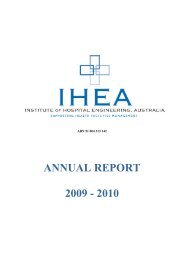Design for maintenance from the viewpoint of sustainable hospital ...
Design for maintenance from the viewpoint of sustainable hospital ...
Design for maintenance from the viewpoint of sustainable hospital ...
Create successful ePaper yourself
Turn your PDF publications into a flip-book with our unique Google optimized e-Paper software.
Ar t i cl e<br />
Building services design<br />
incorporating <strong>maintenance</strong><br />
The intensification <strong>of</strong> building services installations and <strong>the</strong><br />
increased use <strong>of</strong> modern technology has resulted in modern<br />
<strong>hospital</strong>s being one <strong>of</strong> <strong>the</strong> most complex <strong>of</strong> present day<br />
building types. It is important, <strong>the</strong>re<strong>for</strong>e, that <strong>the</strong> subject <strong>of</strong><br />
<strong>maintenance</strong> needs to be addressed much sooner in <strong>the</strong><br />
design stage to ensure that <strong>the</strong> design <strong>of</strong> proper <strong>maintenance</strong><br />
is fully integrated into a building design.<br />
The implications <strong>of</strong> building services installations on <strong>hospital</strong><br />
design are many and varied with <strong>the</strong>ir inter-relationships<br />
complex. These implications not only influence <strong>the</strong> planning<br />
process <strong>of</strong> design but in many instances actually dictate <strong>the</strong><br />
planning (not just two-dimensional, but three-dimensional<br />
considerations <strong>for</strong> <strong>the</strong> accommodation <strong>of</strong> services, etc.). The<br />
implications <strong>of</strong> building services permeates throughout every<br />
aspect <strong>of</strong> <strong>hospital</strong> design so that <strong>the</strong> resulting whole becomes<br />
an integrated matrix <strong>of</strong> building fabric and building services<br />
with elements interdependent on each o<strong>the</strong>r <strong>for</strong> function,<br />
support, protection, operation and <strong>maintenance</strong>.<br />
The effect <strong>of</strong> <strong>the</strong> building services design not only<br />
encompasses <strong>the</strong> consideration <strong>of</strong> simply containing<br />
<strong>the</strong> various services, but also <strong>the</strong> parallel effects <strong>of</strong> <strong>the</strong><br />
construction method, accommodation <strong>of</strong> services and <strong>the</strong><br />
future <strong>maintenance</strong> needs. All in all, <strong>hospital</strong> design and<br />
building services are one which cannot be separated or<br />
considered in individual categories, and without team ef<strong>for</strong>t,<br />
it is impossible to produce a useful, flexible and <strong>sustainable</strong><br />
<strong>hospital</strong>.<br />
The <strong>hospital</strong> services designer has a range <strong>of</strong> equipment<br />
<strong>from</strong> which to select, can dictate how it will be installed and<br />
how <strong>the</strong> components will be brought toge<strong>the</strong>r to <strong>for</strong>m <strong>the</strong><br />
various systems to produce a functioning building. A multidisciplined<br />
design team has pr<strong>of</strong>essional responsibility to<br />
design out <strong>maintenance</strong> and/or make suitable provisions <strong>for</strong><br />
<strong>maintenance</strong>. The building services designer should have a<br />
higher pr<strong>of</strong>essional responsibility to influence <strong>the</strong> remainder<br />
<strong>of</strong> <strong>the</strong> team in <strong>the</strong> decision making process in relation to<br />
<strong>the</strong> neglected <strong>maintenance</strong> <strong>of</strong> services after <strong>the</strong>ir physical<br />
installation. Clearly, <strong>the</strong> design process can have <strong>the</strong> single<br />
largest impact on <strong>sustainable</strong> development. Cutting back on<br />
<strong>the</strong> time and resources required <strong>for</strong> a good design is a recipe<br />
<strong>for</strong> delivering poor quality outcomes.<br />
<strong>Design</strong>ing sustainability in a project life<br />
In <strong>the</strong> construction industry, many design engineers design<br />
<strong>the</strong> building services systems, supervise <strong>the</strong> installations<br />
and handover to <strong>the</strong>ir clients, wash <strong>the</strong>ir hands and leave <strong>the</strong><br />
operation and <strong>maintenance</strong> (O&M) staff to suffer <strong>the</strong> rest <strong>of</strong><br />
<strong>the</strong> 50 years. Some building services design engineers are<br />
too keen to apply available technology without due regard to<br />
<strong>the</strong> required provisions <strong>for</strong> <strong>maintenance</strong> and O&M staff have<br />
little chance to participate in <strong>the</strong> design stage. On <strong>the</strong> o<strong>the</strong>r<br />
hand, <strong>the</strong> know-how in industrial plant O&M is not adequately<br />
applied in buildings. The following sections highlight some<br />
important issues <strong>for</strong> consideration when contemplating <strong>the</strong><br />
design <strong>of</strong> a <strong>sustainable</strong> building.<br />
Control <strong>of</strong> <strong>maintenance</strong><br />
The primary consideration <strong>of</strong> a building design is <strong>the</strong><br />
production <strong>of</strong> a functional facility. Since <strong>the</strong> functional<br />
requirement drives <strong>the</strong> design, <strong>the</strong>re is a tendency to<br />
concentrate on this aspect <strong>of</strong> <strong>the</strong> design at <strong>the</strong> expense <strong>of</strong><br />
o<strong>the</strong>r considerations, especially <strong>maintenance</strong> as <strong>the</strong> last thing<br />
on <strong>the</strong> designer’s mind. However, <strong>the</strong> conceptual phase <strong>of</strong> a<br />
design is <strong>the</strong> single point in time at which <strong>the</strong>re is control over<br />
<strong>the</strong> future <strong>maintenance</strong> and operating cost <strong>of</strong> <strong>the</strong> facility. The<br />
ability to control or modify <strong>maintenance</strong> diminishes <strong>from</strong> <strong>the</strong><br />
earliest step in <strong>the</strong> design process as shown in table below.<br />
Important consideration <strong>for</strong> good <strong>maintenance</strong><br />
Problems <strong>of</strong> <strong>maintenance</strong> will result in high cost penalties<br />
including loss <strong>of</strong> service, high cost <strong>of</strong> repairs and, sometimes,<br />
unnecessary building damage. It is important, <strong>the</strong>re<strong>for</strong>e, to<br />
consider <strong>the</strong> <strong>maintenance</strong> operational policy at an early stage<br />
in <strong>the</strong> design process to ensure that a maintainable building is<br />
possible.<br />
Factors determining <strong>the</strong> approaches are:<br />
• Capital costs<br />
• Complexity <strong>of</strong> building design and intensity <strong>of</strong><br />
engineering services in <strong>the</strong> building<br />
STAGE<br />
Concept<br />
<strong>Design</strong><br />
Construction<br />
Building in use (a life <strong>of</strong>)<br />
50 to 60 years<br />
CONTROL<br />
Total control – building and services can be tailored to any <strong>maintenance</strong> philosophy;<br />
designing out <strong>maintenance</strong> will eliminate most problems.<br />
Total control - flexibility remains to select systems which have low <strong>maintenance</strong> requirements.<br />
Very limited control – design is fixed; difficult to change design but still possible at high cost;<br />
inspection will identify <strong>maintenance</strong> problems (not ALL).<br />
No control – <strong>maintenance</strong> problems will develop and appear.<br />
Repair – very limited control, minor corrections to <strong>maintenance</strong> are possible.<br />
Replacement – still limited control, but can reduce on-going problems.<br />
Improvement/modification – control flexibility is a little better, but may give good control<br />
(NOT TOTAL unless <strong>the</strong> whole system can be changed).<br />
34<br />
The Australian Hospital Engineer
















